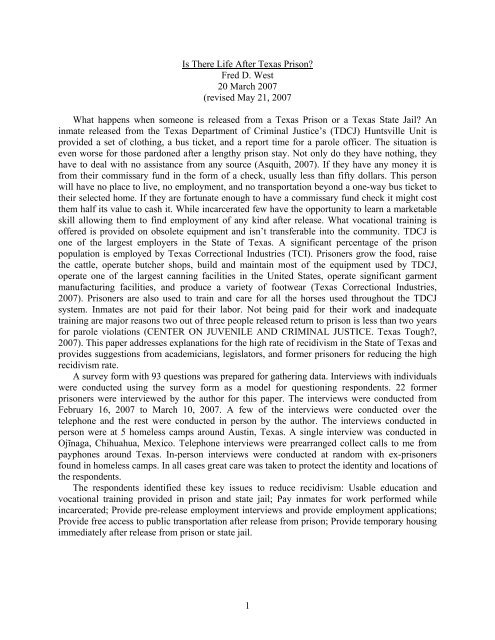The Secret Society: Descendants of Crypto-Jews in the San Antonio ...
The Secret Society: Descendants of Crypto-Jews in the San Antonio ...
The Secret Society: Descendants of Crypto-Jews in the San Antonio ...
You also want an ePaper? Increase the reach of your titles
YUMPU automatically turns print PDFs into web optimized ePapers that Google loves.
Is <strong>The</strong>re Life After Texas Prison?<br />
Fred D. West<br />
20 March 2007<br />
(revised May 21, 2007<br />
What happens when someone is released from a Texas Prison or a Texas State Jail? An<br />
<strong>in</strong>mate released from <strong>the</strong> Texas Department <strong>of</strong> Crim<strong>in</strong>al Justice’s (TDCJ) Huntsville Unit is<br />
provided a set <strong>of</strong> cloth<strong>in</strong>g, a bus ticket, and a report time for a parole <strong>of</strong>ficer. <strong>The</strong> situation is<br />
even worse for those pardoned after a lengthy prison stay. Not only do <strong>the</strong>y have noth<strong>in</strong>g, <strong>the</strong>y<br />
have to deal with no assistance from any source (Asquith, 2007). If <strong>the</strong>y have any money it is<br />
from <strong>the</strong>ir commissary fund <strong>in</strong> <strong>the</strong> form <strong>of</strong> a check, usually less than fifty dollars. This person<br />
will have no place to live, no employment, and no transportation beyond a one-way bus ticket to<br />
<strong>the</strong>ir selected home. If <strong>the</strong>y are fortunate enough to have a commissary fund check it might cost<br />
<strong>the</strong>m half its value to cash it. While <strong>in</strong>carcerated few have <strong>the</strong> opportunity to learn a marketable<br />
skill allow<strong>in</strong>g <strong>the</strong>m to f<strong>in</strong>d employment <strong>of</strong> any k<strong>in</strong>d after release. What vocational tra<strong>in</strong><strong>in</strong>g is<br />
<strong>of</strong>fered is provided on obsolete equipment and isn’t transferable <strong>in</strong>to <strong>the</strong> community. TDCJ is<br />
one <strong>of</strong> <strong>the</strong> largest employers <strong>in</strong> <strong>the</strong> State <strong>of</strong> Texas. A significant percentage <strong>of</strong> <strong>the</strong> prison<br />
population is employed by Texas Correctional Industries (TCI). Prisoners grow <strong>the</strong> food, raise<br />
<strong>the</strong> cattle, operate butcher shops, build and ma<strong>in</strong>ta<strong>in</strong> most <strong>of</strong> <strong>the</strong> equipment used by TDCJ,<br />
operate one <strong>of</strong> <strong>the</strong> largest cann<strong>in</strong>g facilities <strong>in</strong> <strong>the</strong> United States, operate significant garment<br />
manufactur<strong>in</strong>g facilities, and produce a variety <strong>of</strong> footwear (Texas Correctional Industries,<br />
2007). Prisoners are also used to tra<strong>in</strong> and care for all <strong>the</strong> horses used throughout <strong>the</strong> TDCJ<br />
system. Inmates are not paid for <strong>the</strong>ir labor. Not be<strong>in</strong>g paid for <strong>the</strong>ir work and <strong>in</strong>adequate<br />
tra<strong>in</strong><strong>in</strong>g are major reasons two out <strong>of</strong> three people released return to prison is less than two years<br />
for parole violations (CENTER ON JUVENILE AND CRIMINAL JUSTICE. Texas Tough?,<br />
2007). This paper addresses explanations for <strong>the</strong> high rate <strong>of</strong> recidivism <strong>in</strong> <strong>the</strong> State <strong>of</strong> Texas and<br />
provides suggestions from academicians, legislators, and former prisoners for reduc<strong>in</strong>g <strong>the</strong> high<br />
recidivism rate.<br />
A survey form with 93 questions was prepared for ga<strong>the</strong>r<strong>in</strong>g data. Interviews with <strong>in</strong>dividuals<br />
were conducted us<strong>in</strong>g <strong>the</strong> survey form as a model for question<strong>in</strong>g respondents. 22 former<br />
prisoners were <strong>in</strong>terviewed by <strong>the</strong> author for this paper. <strong>The</strong> <strong>in</strong>terviews were conducted from<br />
February 16, 2007 to March 10, 2007. A few <strong>of</strong> <strong>the</strong> <strong>in</strong>terviews were conducted over <strong>the</strong><br />
telephone and <strong>the</strong> rest were conducted <strong>in</strong> person by <strong>the</strong> author. <strong>The</strong> <strong>in</strong>terviews conducted <strong>in</strong><br />
person were at 5 homeless camps around Aust<strong>in</strong>, Texas. A s<strong>in</strong>gle <strong>in</strong>terview was conducted <strong>in</strong><br />
Ojĩnaga, Chihuahua, Mexico. Telephone <strong>in</strong>terviews were prearranged collect calls to me from<br />
payphones around Texas. In-person <strong>in</strong>terviews were conducted at random with ex-prisoners<br />
found <strong>in</strong> homeless camps. In all cases great care was taken to protect <strong>the</strong> identity and locations <strong>of</strong><br />
<strong>the</strong> respondents.<br />
<strong>The</strong> respondents identified <strong>the</strong>se key issues to reduce recidivism: Usable education and<br />
vocational tra<strong>in</strong><strong>in</strong>g provided <strong>in</strong> prison and state jail; Pay <strong>in</strong>mates for work performed while<br />
<strong>in</strong>carcerated; Provide pre-release employment <strong>in</strong>terviews and provide employment applications;<br />
Provide free access to public transportation after release from prison; Provide temporary hous<strong>in</strong>g<br />
immediately after release from prison or state jail.<br />
1
















